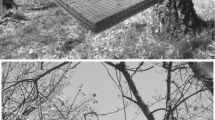Summary
A laboratory experiment with the broad-headed skink (Eumeces laticeps) involving staged agonistic encounters demonstrates that larger males have an advantage over smaller ones in agonistic bouts. Field data on head wounds produced by intraspecific fighting during the breeding season show a much higher frequency of new wounds among males over 100 mm in snout-vent-length than in smaller males. The significant difference in new-wound frequency strongly suggests avoidance of fights by the small males, which is corroborated by laboratory and field observations. Access by males to reproductively active females depends on the ability to defeat other males in aggressive contests virtually always involving head biting if the males are of nearly equal size. Because the probability of winning agonistic encounters increases with size, young males avoid fights with older males. Aggressive contests with larger males and reproductive attempts other than courtship in the absence of larger males are deferred.
Aggressive behavior in E. laticeps may be employed in direct defense of females, but might also be expressed in defense of specific sites and/or territories. In the laboratory, males in their home cages were significantly more likely to win encounters with males of similar size than were males fighting in the home cages of opponents. This suggests that encounter site could be important in determining encounter outcome and that field study of possible site defense or territoriality is needed.
Similar content being viewed by others
References
Boag DA (1973) Spatial relationships among members of a population of wall lizards. Oecologia (Berlin) 12:1–13
Brackin MF (1978) The relation of rank to physiological state in Cnemidophorus sexlineatus hierarchies. Herpetologica 34:185–191
Cade W (1980) Alternative male reproductive strategies. Fla Entomol 63:30–45
Clarke DR, Hall RJ (1970) Function of the blue tail-coloration of the five-lined shink (Eumeces fasciatus). Herpetologica 26:271–274
Cooper WE Jr, Vitt LJ (1984) Conspecific odor detection by the male broad-headed skink, Eumeces laticeps: Effects of sex and site of odor source and of male reproductive condition. J Exp Zool 230:199–209
Cooper WE Jr, Vitt LJ (1986) Blue tails and autotomy: Enhancement of predation avoidance in juvenile skinks. Z Tierpsychol 70:265–276
Cooper WE Jr, Vitt LJ (1987a) Induction of orange head coloration and activation of courtship and aggression by testosterone in the male broad-headed skink (Eumeces laticeps). J Herpetol (in press)
Cooper WE Jr, Vitt LJ (1987b) Intraspecific and interspecific aggression in lizards of the scincid genus Eumeces: Pheromonal recognition of conspecific sexual competitors. Herpetologica 43:7–14
Cooper WE Jr, Vitt LJ (1987c) Lizard sexual behavior and pheromones: Ethological isolating mechanisms in the fasciatus group of the scincid genus Eumeces. Ethology
Cooper WE Jr, Vitt LJ, Vangilder LD, Gibbons JW (1983) Natural nest sites and brooding behavior of Eumeces fasciatus. Herpetol Rev 14:65–66
Dugan B (1982) The mating behavior of the green iguana. Iguana iguana. In: Burghardt GW, Rand AS (eds) Iguanas of the world: their behavior, ecology, and conservation. Noyes Publications, Park Ridge NJ, pp 320–341
Ferner JW (1974) Home-range size and overlap in Sceloporus undulatus erythrocheilus (Reptilia: Iguanidae). Copeia 1974:332–337
Fitch HS (1954) Life history and ecology of the five-lined skink Eumeces fasciatus. Univ Kans Publ Mus Nat Hist 8:1–156
Fitch HS (1955) Habits and adaptations of the great plains skink (Eumeces obsoletus). Ecol Monogr 25:59–83
Fitch HS, von Achen PL (1977) Spatial relationships and seasonality in the skinks Eumeces fasciatus and Scincella laterale in northeastern Kansas. Herpetologica 33:303–313
Goin OB, Goin CJ (1951) Notes on the natural history of the lizard Eumeces laticeps in northern Florida. Q J Fla Acad Sci 14:3–8
Greenberg B, Noble GK (1944) Social behavior of the American chameleon (Anolia carolinensis). Physiol Zool 17:392–439
Gross MR, Charnov EL (1980) Alternative life histories in bluegill sunfish. Proc US Natl Acad Sci 77:6937–6940
Call RJ (1971) Ecology of a population of great plains skink (Eumeces obsoletus). Univ Kans Sci Bull 49:357–388
Maynard Smith J, Price GR (1973) The logic of animal conflict. Nature 246:15–18
Mount RH (1963) The natural history of the red-tailed skink, Eumeces egregius Baird. Am Midl Nat 70:356–385
Parker GA (1974) Assessment strategy and the evolution of fighting behaviour. J Theor Biol 47:223–243
Perrill SA (1980) Social communication in Eumeces inexpectatus. J Herpetol 14:129–135
Perrill SA, Gerhardt HC, Daniel R (1978) Sexual parasitism in the green tree frog (Hyla cinerea). Science 200:1179–1180
Rand AS (1967) Ecology and social organization in the iguanid lizard Anolis lineatopus. Proc US Natl Mus 122:1–79
Ruby DE (1978) Seasonal changes in the territorial behavior of the iguanid lizard Sceloporus jarrovi. Copeia 1978:430–438
Ruby DE (1981) Phenotypic correlates of male reproductive success in the lizard, Sceloporus jarrovi. In: Alexander RD, Tinkle DW (eds). Natural selection and social behavior. Chiron Press, pp 96–107
Schoener TW (1979) Inferring the properties of predation and other injury-producing agents from injury frequencies. Ecology 60:1110–1115
Stamps JA (1978) A field study of the ontogeny of social behavior in the lizard Anolis aeneus. Behaviour 66:1–31
Stamps JA (1983) Sexual selection, sexual dimorphism, and territoriality. In: Huey RB, Pianka ER, Schoener TW (eds). Lizard ecology, studies of a model organism. Harvard University Press, pp 169–204
Tanner WW (1957) A taxonomic and ecological study of the western skink (Eumeces skiltonianus). Great Basin Nat 17:59–94
Tokarz RR (1985) Body size as a factor determining dominance in staged agonistic encounters between male brown anoles (Anolis sagrei). Anim Behav 33:746–753
Trivers RL (1976) Sexual selection and resource-accruing abilities in Anolis garmani. Evolution 30:253–269
Vitt LJ, Cooper WE Jr (1985) The evolution of sexual dimorphism in the skink Eumeces laticeps: An example of sexual selection. Can J Zool 63:995–1002
Vitt LJ, Cooper WE Jr (1986a) Foraging and diet of a diurnal predator (Eumeces laticeps) feeding on hidden prey. J Herpetol 20:404–411
Vitt LJ, Cooper WE Jr (1986b) Skink reproduction and sexual dimorphism: Eumeces fasciatus in the southeastern United States, with notes on Eumeces inexpectatus. J Herpetol 20:65–76
Werner DI (1978) On the biology of Tropidurus delanonis Baur (Iguanidae). Z Tierpsychol 47:337–395
Werner DI (1982) Social organization and ecology of land iguanas, Conolophus subcristatus on Fernandina Island, Galapagos. In: Burghardt GM, Rand AS (eds) Iguanas of the world: their behavior, ecology, and conservation. Noyes Publications, Park Ridge NJ, pp 342–364
Wilder CD Jr (1962) Dominance-subordinance relationships in the southeastern five-lined skink, Eumeces inexpectatus Taylor. Unpublished thesis. Univ Florida, Gainesville
Author information
Authors and Affiliations
Rights and permissions
About this article
Cite this article
Cooper, W.E., Vitt, L.J. Deferred agonistic behavior in a long-lived scincid lizard Eumeces laticeps . Oecologia 72, 321–326 (1987). https://doi.org/10.1007/BF00377558
Received:
Issue Date:
DOI: https://doi.org/10.1007/BF00377558




